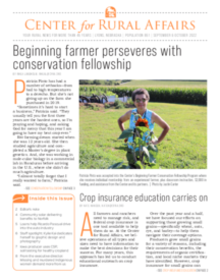Editor’s Note
What is the best thing about traveling? Visiting small towns, hands down.
I haven’t traveled much in the last couple of years due to the pandemic, but I was able to get to Georgia and Colorado for weddings, Arizona and Utah for a conference, and Minnesota for an actual vacation (because North Shore of Lake Superior is my all-time favorite).
You can usually find me on hiking trails in the morning, and in town in the afternoon. I gravitate toward the gift shops, art galleries (bonus if an artist is working), and bookstores. I only go to local restaurants, breweries, and coffee shops, sometimes browsing the menu beforehand to see what types of local food are offered.
On the long drives, I consider the Center for Rural Affairs’ work and how we affect these communities. Just last year, one of our staff members testified in Washington in support of funding for Women’s Business Centers. These organizations are found throughout the U.S. in almost every state, and benefit their local small businesses.
Our farm bill efforts in Washington make a difference in these towns as well—as I travel, this is most visibly the Rural Microenterprise Assistance Program and the Value-Added Producer Grant.
While I currently live and grew up in Lyons, Nebraska, where our home office is located, our work does not stop here. It doesn’t stop in Nebraska or even Iowa, South Dakota, or Minnesota where staff are located.
To learn more about our policy work, visit cfra.org or shoot me an email and I’ll get you in touch with our staff.
Inside this issue
Beginning farmer perseveres with conservation fellowship - Patricia Pinto has had a number of setbacks—from hail to high temperatures to a derecho. But she’s not giving up on the farm she purchased in 2019.
Crop insurance education carries on - All farmers and ranchers need to manage risk, and federal crop insurance is one tool available to help them do so. At the Center for Rural Affairs, we believe operations of all types and sizes need to have information to make the best decisions for their success. For many years, this approach has led us to conduct educational outreach on crop insurance.
Community solar delivering benefits to Norfolk - Nebraskans are looking for ways to save money as inflation pinches pocketbooks across the state. Residents of Norfolk now have the opportunity to save on their utility bills thanks to a new community solar development built through Nebraska Public Power District’s (NPPD) SunWise Community Solar Program.
Loans help Ricardo Pascual drive into the auto industry - Ricardo Pascual’s love of cars started when he was a young boy. Watching his father fix up and trade different automobiles throughout his childhood sparked a passion to pursue the dream of having his own auto sales business.
Staff spotlight: Kylie Kai dedicates herself to graphic design and photography - During the past several years, Kylie Kai has been the driving force behind most of the graphic design elements and photographs seen throughout the Center for Rural Affairs’ published work.
Iowa producer uses CSP, soil testing for healthy cropland - Eric Hill knows good soil. The Iowa producer, who manages his family’s 3,000-acre farming operation near Nevada, Iowa, has spent more than 20 years caring for the soil that surrounds the plot of land purchased by his parents in the 1970s.
From the desk of the executive director: Missing and murdered Indigenous women demand more from us - Recently, I attended a memorial for Ashleigh Wabasha. Ashleigh was 19 years old and a member of the Santee Sioux Nation in Nebraska. She was a close friend of an employee of the Center for Rural Affairs. Ashleigh went missing earlier this year. She was gone for three weeks before her body was found. Unfortunately, her story is far too common.
Sign up for the free newsletter here.


